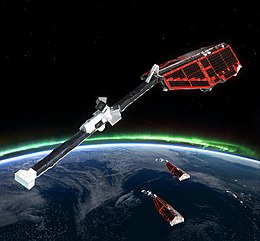
Back Swarm (nau espacial) Catalan Swarm Czech SWARM German Swarm (misión de la ESA) Spanish SWARM Finnish SWARM French Swarm Galician Swarm (wahana antariksa) ID Progetto Swarm Italian SWARM (人工衛星) Japanese
 Artist's view of the three Swarm spacecraft | |
| Mission type | Earth's magnetic field observation |
|---|---|
| Operator | ESA |
| COSPAR ID | SWARM A: 2013-067B SWARM B: 2013-067A SWARM C: 2013-067C |
| SATCAT no. | SWARM A: 39452 SWARM B: 39451 SWARM C: 39453 |
| Website | ESA Swarm homepage |
| Mission duration | 4 years (planned) 10 years, 11 months, 25 days (elapsed) |
| Spacecraft properties | |
| Manufacturer | Astrium |
| Launch mass | 468 kg |
| Dry mass | 369 kg |
| Dimensions | 9.1 m × 1.5 m × 0.85 m |
| Power | 608 watts |
| Start of mission | |
| Launch date | 22 November 2013, 12:02:29 UTC |
| Rocket | Rokot/Briz-KM |
| Launch site | Plesetsk, Site 133/3 |
| Contractor | Eurockot |
| Orbital parameters | |
| Reference system | Geocentric |
| Regime | Polar orbit |
| Perigee altitude | Swarm A: ≤460 kilometres (290 mi) Swarm C: ≤460 kilometres (290 mi) Swarm B: ≤530 kilometres (330 mi) |
| Apogee altitude | Swarm A: ≤460 kilometres (290 mi) Swarm C: ≤460 kilometres (290 mi) Swarm B: ≤530 kilometres (330 mi) |
| Inclination | Swarm A: 87.4° Swarm C: 87.4° Swarm B: 88.0° |
| Mean motion | 15 |
| Transponders | |
| Band | S Band |
| Frequency | 2 GHz |
| Bandwidth | 6Mbit/s download 4 kbit/s upload |
| Instruments | |
| VFM: Vector Field Magnetometer ASM: Absolute Scalar Magnetometer EFI: Electric Field Instrument ACC: Accelerometer LRR: Laser Range Reflector | |

| |
Swarm is a European Space Agency (ESA) mission to study the Earth's magnetic field. High-precision and high-resolution measurements of the strength, direction and variations of the Earth's magnetic field, complemented by precise navigation, accelerometer and electric field measurements, will provide data for modelling the geomagnetic field and its interaction with other physical aspects of the Earth system. The results offer a view of the inside of the Earth from space, enabling the composition and processes of the interior to be studied in detail and increase our knowledge of atmospheric processes and ocean circulation patterns that affect climate and weather.